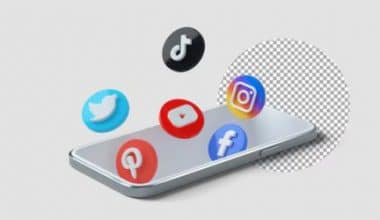Let us paint a scene together. It’s a crisp Friday evening, and you’re relaxing at home, reading through your email inbox. Suddenly, you notice a message from your favorite coffee shop offering an enticing discount on your go-to cappuccino. As you sip your tea and consider the offer, your phone vibrates with a notification. Curious, you visit Instagram and discover a nicely produced ad from the same coffee business promoting the same promotion. Something beautiful happens at that point: you feel a connection with the brand. It’s as if they tapped into your thoughts and gave you exactly what you needed at the appropriate time. This, my friend, is the essence of integrated communication: the art of constructing a cohesive story that resonates across all channels, leaving your audience feeling understood, respected, and eager to participate.
So, the next time you receive a perfectly timed email or come across a riveting social media post, take a moment to appreciate the seamless experience that has been tailored specifically for you. It’s not magic; it’s the power of integrated communications at work, building connections that transcend pictures and displays and leaving a lasting imprint on hearts and minds. As a result, in this article, I’ll delve into the intricacies of integrated communications, exploring how to align your messaging across various platforms effectively.
Key Takeaways
- Integrated communications ensure that your brand speaks with one voice across all channels, building brand recognition and trust.
- By delivering cohesive and personalized messages across multiple touchpoints, integrated communications foster meaningful connections with customers, driving engagement and loyalty.
- Technologies like AI, blockchain, and IoT are shaping the future of integrated communications, enabling hyper-personalization, enhanced trust, and seamless connectivity.
- Investing in integrated communication strategies is essential for businesses looking to gain a competitive edge in the digital age, driving long-term growth and success.
Overview of Integrated Communications
Let’s go back in time. Picture the 1950s: advertisers had three simple ways to communicate with their target audience: TV, radio, and print. Moving forward to the present, the terrain resembles a huge metropolis rather than a simple junction. We have social media, blogs, emails, websites, applications, and more, all vying for our attention and singing from the same hymn sheet.
That is, the emergence of digital media has transformed how we communicate. I recall my first experience with this transition in the early 2000s, when social media was developing as the next big thing. As businesses, we were suddenly able to use a myriad of channels, including Facebook, Twitter, Instagram, LinkedIn, and countless more.
Take Starbucks, for example. Whether you’re ordering a coffee in-store, visiting their website, or following them on social media, you can expect the same experience: courteous baristas, a pleasant ambiance, and the distinct aroma of freshly brewed coffee. Consistency is what keeps customers coming back.
What is integrated communication?
Integrated communication entails more than simply saying the same thing everywhere. It is about creating a cohesive approach that includes your content, branding, and messaging. In turn, this guarantees that all of your communication initiatives function in tandem, resulting in a seamless client experience. At its foundation, integrated communications is about unity; it’s the art of making sure that every piece of your brand’s communication puzzle fits together perfectly.
Whether you’re creating a social media post, an email newsletter, or a website, each message should work together to create a consistent and engaging image of your business. For example, if your brand is known for its lively and amusing tone, this personality should show through in everything from your tweets to your customer support emails. This isn’t just about maintaining a consistent voice; it’s about reinforcing your brand’s identity and values across every touchpoint.
Key Elements to Consider in Integrated Communications
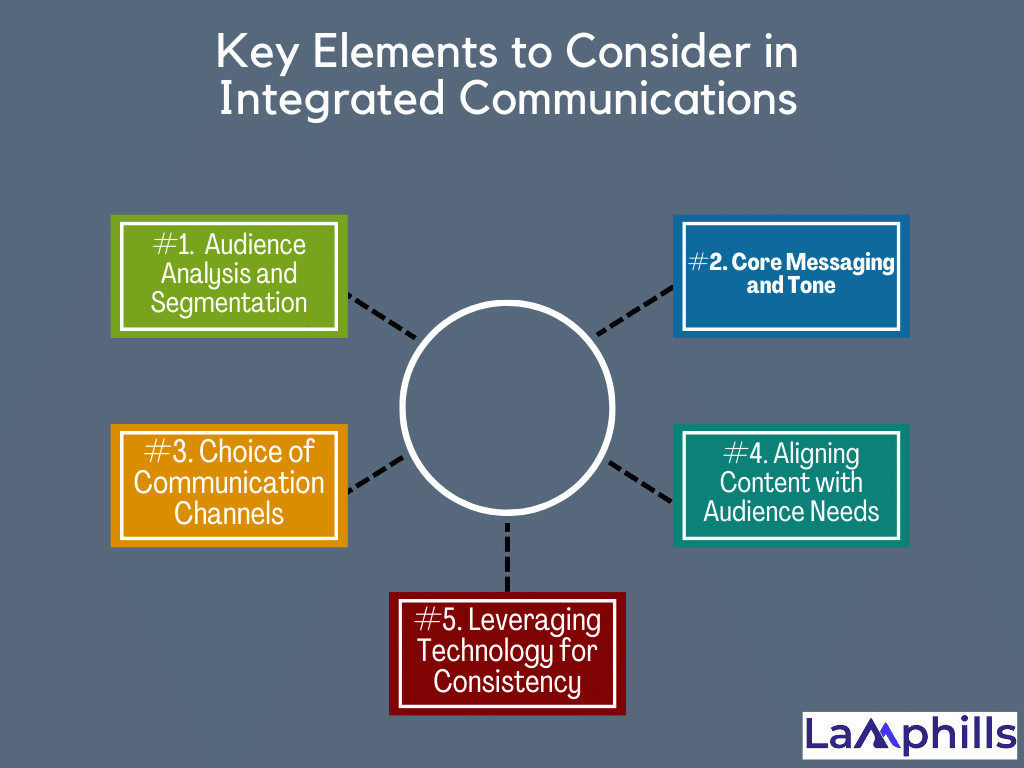
Integrated communications may sound like complicated marketing jargon, but it is just about conveying a consistent and appealing story across all of the channels through which your company engages with customers. Whether through social media postings, email newsletters, or your website, your audience should feel as if they are hearing the same voice no matter where they interact with you. Let’s get deeper into the crucial components that keep your tale engaging and consistent across all mediums.
#1. Audience Analysis and Segmentation
Imagine that you’re hosting a dinner party. To make it memorable, you’d want to know your guests—what they like to eat, their conversation interests, and even their dietary restrictions. The same principle applies to your audience in integrated communications.
In other words, to communicate effectively, you first need to understand who your audience is. This involves delving into their demographics (age, gender, location), psychographics (interests, values, lifestyle), and behaviors (how they interact with your brand).
#2. Core Messaging and Tone
Your brand’s communications revolve around its fundamental message. It’s the fundamental notion you want your audience to remember, regardless of the media or channel. This statement should summarize your company’s mission, values, and unique selling offer.
For example, Apple’s main message focuses on innovation, quality, and user experience. Whether you’re watching a slick TV commercial, perusing their website, or unwrapping a product, you’ll get a sense of innovative technology geared to improve your life.
In addition, the tone of your message reflects its individuality. It is the style and tone with which your message is presented, and it must be consistent across all channels to establish a distinctive brand identity.
#3. Choice of Communication Channels
Not all communication channels are created equal, and each has a unique purpose. You must determine where your audience spends their time and how they prefer to get information. This is similar to knowing which social occasions your friends prefer: some may enjoy dinner parties, while others thrive on casual coffee meet-ups.
I understand the need to be everywhere at once, but spreading oneself too thin might dilute your message. It is preferable to master a few channels where you can produce high-quality, consistent material than to be poor in many.
#4. Aligning Content with Audience Needs
Your content should be relevant to your audience’s requirements and interests. This entails not just understanding what individuals want to hear, but also communicating in a way that provides value to their lives.
For a health and wellness brand, this may include providing recipes, workout recommendations, and mental health guidance. Each piece of content should be created with the audience’s lifestyle and preferences in mind, leaving them feeling understood and cherished by the brand.
Keep in mind that audience needs are not static; they change. Regularly requesting and analyzing feedback allows you to stay current with these developments and alter your messaging accordingly.
#5. Utilizing Technology for Consistency
In today’s digital world, technology is your ally in ensuring seamless communication. Customer relationship management (CRM) systems, content management platforms, and social media schedulers can all help you maintain consistency and organization in your communications.
For example, Hootsuite and Buffer allow you to schedule and manage social media postings across many platforms using a single dashboard. This ensures that your posts are consistent and timely, without the inconvenience of signing in and out of several accounts. Additionally, automation and AI may assist in personalizing your communications at scale, ensuring that each consumer receives relevant messages while maintaining the essential theme.
Email marketing tools, such as Mailchimp, use automation to deliver personalized emails depending on client behavior and preferences. A bookstore, for instance, may send a tailored recommendation email based on a customer’s past purchases, all while maintaining the brand’s friendly and knowledgeable tone. This checklist will also guide you through the process of exploring, assessing, and integrating technologies
Digital Transformation and Its Impact on Communications
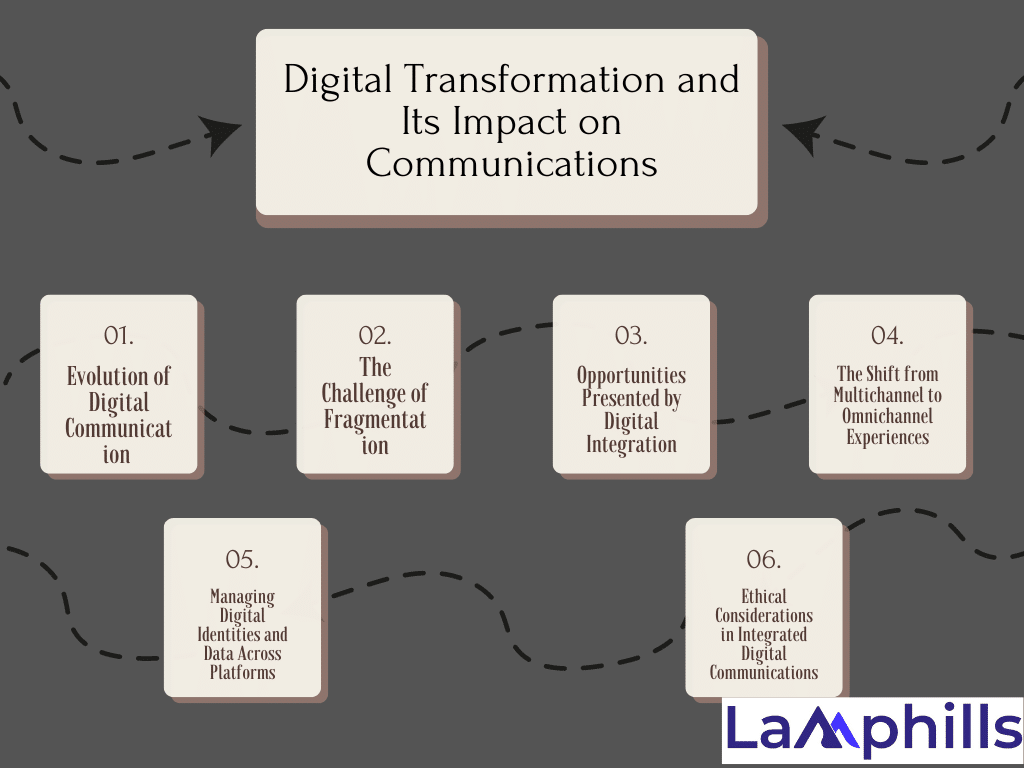
In this digital age, the way we communicate has undergone a profound transformation. Let’s take a closer look at how this evolution has reshaped the landscape of business communications, presenting both challenges and opportunities for brands like yours.
#1. Evolution of Digital Communication Channels
Think about the early days of the internet: dial-up connections, clunky websites, and email addresses ending in “@aol.com.” Fast forward to now, and the internet scene has dramatically changed. We now have access to a plethora of channels, each with its own way of connecting with our audience.
I recall how excited I was to create my first MySpace profile (yeah, I’m dating myself!). Back then, you could personalize your profile with glittering backgrounds and song lyrics. We had no idea that this was only the beginning of a digital revolution that would permanently alter the way we communicate.
From social media platforms like Facebook, Instagram, and Twitter to email, mobile apps, and websites, the options are endless. Each platform has its quirks and nuances, but they all serve one purpose: to facilitate communication and connection in the digital world.
#2. The Challenge of Fragmentation
As the saying goes, great power equals great responsibility. While the development of digital platforms provides unprecedented opportunities for reaching our target audience, it also introduces a fundamental challenge: fragmentation.
Assume you’re a customer seeking to interact with a brand across numerous platforms. You receive an email touting a special offer, but when you visit the brand’s website, there is no mention of the campaign. Confused, you turn to social media for answers, only to discover inconsistent facts. This disorganized experience will leave you feeling frustrated and distant from the brand.
Businesses frequently struggle to maintain consistent messaging across these various platforms, resulting in hazards such as contradicting messages, customer confusion, and, eventually, a loss of confidence and credibility.
#3. Opportunities Presented by Digital Integration
But fear not, for where there are challenges, there are also opportunities. Digital integration holds the key to overcoming fragmentation and unlocking new possibilities for engaging with your audience.
a.Data Analytics: By leveraging data analytics, firms can acquire significant insights into audience behavior, preferences, and trends. This information enables you to adjust your messaging to resonate with your target audience on a deeper level, ensuring that each contact seems personalized and relevant.
b. Automation and AI: Automation and artificial intelligence (AI) provide another way to streamline communications and improve the client experience. From chatbots that provide quick support to personalized email campaigns driven by user behavior, automation enables you to deliver the right message to the right person at the right time, eliminating the need for manual involvement.
c. Integration of Customer Feedback: Finally, integrating customer feedback into your communication strategy allows you to refine your messaging based on real-time insights and actionable feedback. Whether it’s through surveys, reviews, or social media comments, listening to your audience and incorporating their input helps ensure that your communications are always on point. Let me share with you the deeper implications of this transformation,
#4. The Shift from Multichannel to Omnichannel Experiences
Assume you’re scheduling a visit to your favorite theme park. In the past, you might have purchased tickets online, received a confirmation email, and downloaded a mobile app to view park maps and wait times. Each channel—the website, email, and app—served a specific purpose yet operated independently of one another.
Now, fast forward to today, and the experience is drastically different. Enter the age of multichannel communication techniques. Unlike multichannel techniques, which consider each channel as a separate entity, genuine omnichannel integration combines all touchpoints seamlessly, giving a cohesive experience across many platforms.
#5. Managing Digital Identities and Data Across Platforms
In a world where our digital identities are spread over multiple platforms, ranging from social media networks to e-commerce websites, maintaining consistency and accuracy becomes a Herculean endeavor. How can you make sure that the John Doe who shops on your website is the same John Doe who interacts with your business on social media?
Example: Imagine yourself as a digital nomad traveling the enormous expanse of the internet. You have profiles on every network, including Facebook, Twitter, Instagram, and LinkedIn, each representing a distinct aspect of your identity. Consider trying to maintain all of these profiles in sync while ensuring that your information is accurate and up-to-date across all channels. It’s a tough task, to say the least.
#6. Ethical Considerations in Integrated Digital Communications
As we navigate the digital realm, we must step cautiously and consider the ethical implications of our activities. In an age where data reigns supreme, privacy, data protection, and permission have become critical factors in integrated digital interactions.
I once received a flood of targeted ads, each of which was remarkably similar to a recent conversation I had with a buddy. It left me feeling uneasy as if my privacy had been violated without my permission. While tailored advertising can improve the user experience when done correctly, it can also cross the line into intrusive areas if not handled with caution.
In other words, balancing personalization and privacy requires a delicate dance, where transparency, consent, and respect for the individual’s rights are paramount. By adopting a customer-centric approach that puts privacy and data protection at the forefront, businesses can build trust and foster meaningful connections with their audience, ensuring that their integrated communication strategies resonate authentically and ethically.
You have the same thing in your article as you have in your PDF.
Strategies for Aligning Messages Across Channels
Welcome to the heart of integrated communications, where the art of storytelling meets the science of strategy. In this section, I’ll explore the essential strategies for ensuring that your message remains consistent and compelling across every channel, from social media to email and beyond. So, let’s roll up our sleeves and dive into the world of message alignment!
#1. Developing a Unified Communication Strategy
Crafting a consistent communication plan isn’t just about throwing spaghetti at the wall and hoping something sticks. It’s about laying a solid foundation that guides every interaction with your audience, ensuring that every message sings in harmony with your brand identity. Creating a consistent communication plan involves several steps:
- Define Your Core Message: What is the key message you want to convey across all channels? This message should be clear, concise, and aligned with your brand values.
- Tailor Your Message for Each Channel: While your core message remains the same, it should be adapted to suit the nuances of each platform. For example, the tone and length of a LinkedIn post will differ from a tweet.
- Ensure Flexibility for Adaptation: Allow room for flexibility so your messaging can be adapted to respond to current events or audience feedback while staying true to your core message.
#2. Creating a Centralized Content Hub
A single content hub serves as a repository for all of your content and messaging guidelines. This guarantees that everyone on your team has access to the same materials, resulting in more consistency across channels.
Imagine your content as a well-oiled machine, with each piece fitting flawlessly into place and propelling your message forward with precision and purpose. That is the strength of a centralized content hub: a single repository containing all of your content and messaging guidelines, ready for access and deployment across all channels.
Benefits: A content hub simplifies content administration and dissemination, allowing for a more consistent message. It also serves as a helpful resource for new team members, allowing them to immediately become acquainted with your brand’s communication approach.
#3. Utilizing Technology for Integration
Assume you’re managing many projects, each with its own set of deadlines and deliverables. It’s like attempting to traverse a maze while blindfolded. That’s where project management software comes in: it serves as a guiding light, assisting you in coordinating activities, tracking progress, and staying on track with deadlines. Whether you’re running a social media campaign or introducing a new product, having the appropriate tools may make all the difference in ensuring that your message is heard loud and clear.
- Tools and Platforms for Synchronizing Communications: Technology plays a crucial role in integrated communications. CRM systems, marketing automation platforms, and content management systems can help synchronize your efforts and maintain consistency.
- Role of Project Management Software in Coordinating Efforts: Project management tools like Trello or Asana can help coordinate your team’s efforts, ensuring that everyone is aligned and working towards the same communication goals.
#4. Leveraging Advanced Analytics and AI
I’ll never forget the first time I saw the power of AI-driven personalization in action. I was exploring an online bookstore when I got a recommendation for a book that appeared perfect for my interests. Intrigued, I clicked ahead to find out more, only to realize that the recommendation was based on my previous purchases and browsing history. It was a lightbulb moment: AI had not only anticipated what I could like but also offered it to me at exactly the correct time, resulting in a fully personalized experience.
In the age of big data and artificial intelligence, the possibilities for message alignment are practically unlimited. By utilizing AI and machine learning, you can uncover valuable insights into customer behavior and preferences, allowing you to tailor your communications with unprecedented precision.
#5. Content Personalization at Scale
Gone are the days of one-size-fits-all marketing. Consumers today want individualized experiences that address their specific needs and interests. But how can you expand customization while maintaining consistency and brand integrity?
Consider yourself a marketing manager tasked with developing a targeted email campaign for a diversified audience. You have tech-savvy millennials, busy parents, and retired baby boomers, all with their own preferences and pain concerns. You may personalize your message for each category while maintaining your brand’s voice and message by using powerful segmentation techniques and dynamic content-generating tools.
#6. Real-time Communication and Response Strategies
In a world that moves at the speed of light, real-time communication is no longer a luxury, but a need. Implementing tools for real-time message change based on quick feedback and data allows you to remain nimble and adaptable in a rapidly changing environment.
Finally, embrace innovation, intelligence, and agility to achieve effective message alignment. By employing advanced analytics and AI, increasing content personalization, and implementing real-time communication and response methods, you can ensure that your messages resonate profoundly with your audience, resulting in meaningful engagement and long-term partnerships.
Examples of Integrated Communications
Welcome to a setting of real-world examples, where we will deconstruct success stories and gain vital insights from the trenches of integrated communications. In this section, I’ll look at case studies of firms that have perfected the art of aligned messaging, provide cautionary tales of integration failures, and identify industry-specific methodologies that tailor strategy to distinct sectors.
#1. Coca-Cola
Coca-Cola is a perfect example of a firm that succeeds at delivering consistent messaging across channels. Coca-Cola’s iconic TV ads, engaging social media campaigns, and experiential marketing events all retain a consistent brand identity while adjusting content to engage with varied audiences throughout the world. Their “Share a Coke” campaign, which personalized bottles with individual names, was flawlessly integrated across television, social media, and in-store activations, increasing brand engagement and sales.
#2. Nike
Nike is another shining example of integrated communications done correctly. They have established a consistent brand narrative that crosses media by using the “Just Do It” tagline and great storytelling in advertising. Whether it’s their motivational social media postings showing athletes or their engaging mobile app providing individualized training regimens, Nike delivers a consistent message of empowerment and athleticism across every touchpoint.
#3. Amazon
Amazon, the e-commerce behemoth, has perfected the art of integrated communications through the use of cutting-edge technology and data-driven initiatives. From tailored product suggestions based on browsing history to targeted email marketing driven by user activity, Amazon provides a consistent and seamless experience across all touchpoints. For example, their usage of AI-powered chatbots for customer support inquiries assures consistent messaging and prompt resolution of issues, thereby improving the entire customer experience.
#4. Google
Google, recognized for its innovation in search and advertising, uses integrated communications to efficiently promote its products and services. They use targeted advertising on platforms such as YouTube and Gmail to offer personalized messages to users based on their interests and search history. Additionally, Google’s annual I/O developer conference serves as a showcase for its latest technologies and innovations, providing a platform for integrated communications that reaches both developers and consumers alike.
Measuring the Success of Integrated Communications
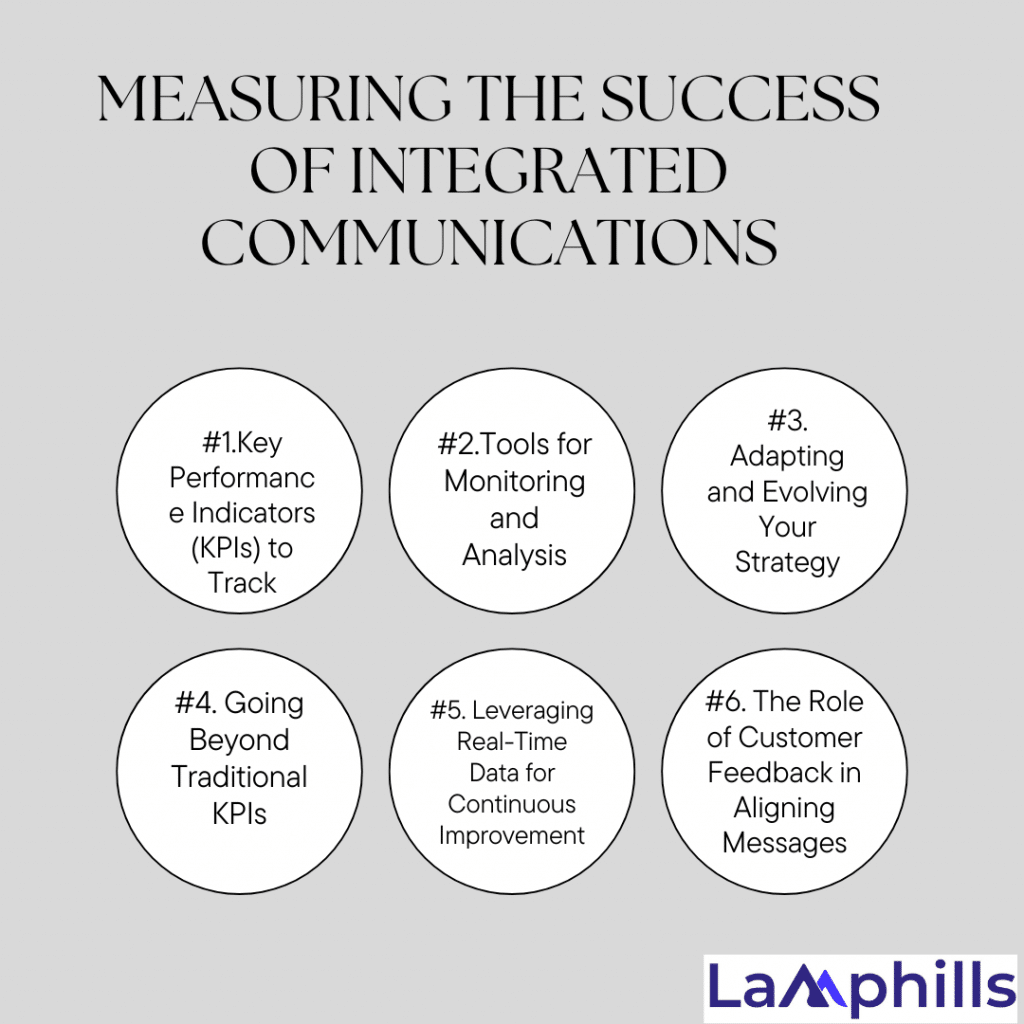
As the saying goes, “What gets measured gets managed.” In the realm of integrated communications, tracking key performance indicators (KPIs), leveraging tools for monitoring and analysis, and adapting your strategy based on data and trends are essential steps to ensure success. Let’s explore each aspect in detail:
#1. Key Performance Indicators (KPIs) to Track
When evaluating the performance of integrated communications, it is critical to focus on indicators that represent engagement, brand sentiment, and overall impact. Examples of tracking metrics include:
- Engagement rates: This contains analytics such as likes, shares, comments, and click-through rates from multiple platforms. These analytics reveal how well your audience is engaging with your content and messages.
- Brand sentiment: Monitor sentiment analysis tools to see how your target audience perceives your brand online. Do they express good, negative, or neutral sentiments? Understanding brand sentiment can help you evaluate the success of your messaging and suggest areas for improvement.
#2. Tools for Monitoring and Analysis
In today’s digital age, there are numerous tools and software available for measuring and assessing performance across channels. From social media analytics platforms to web analytics tools, these services offer priceless insights into audience behavior and campaign performance. For example:
Google Analytics: This sophisticated tool provides a plethora of information about website traffic, user behavior, and conversions. Setting targets and recording events allows you to assess the impact of your integrated communications efforts on website engagement and conversion rates.
Social media management platforms: monitoring mentions, tracking engagement metrics, and scheduling posts across numerous social media networks are all possible with tools like Hootsuite, Sprout Social, and Buffer. These systems allow you to easily monitor the performance of your social media initiatives and find opportunities. for optimization.
#3. Adapting and Evolving Your Strategy
In digital communications, agility is key. As trends shift and consumer preferences evolve, it’s essential to continuously refine your communication strategy based on data and insights. This involves:
- Refining Your Communication Strategy: Analyzing the data gathered from KPIs and monitoring tools to identify what’s working and what’s not. Are certain messaging tactics resonating more with your audience? Are there specific channels driving higher engagement? Use these insights to refine your messaging and channel strategy accordingly.
- Staying Agile and Responsive: The digital landscape is constantly evolving, and your communication strategy must evolve with it. Stay abreast of emerging trends, technological advancements, and shifts in consumer behavior, and be prepared to adapt your strategy accordingly. Whether it’s experimenting with new channels, leveraging emerging technologies, or pivoting your messaging to address changing consumer needs, staying agile and responsive is essential for long-term success.
#4. Going Beyond Traditional KPIs
While metrics like engagement rates and brand sentiment are valuable, they only tell part of the story. To gain a deeper understanding of integrated communication success, we must introduce advanced metrics such as:
- Customer Journey Analysis: By mapping the customer journey across various touchpoints and channels, we can identify key interactions and pain points, gaining insights into how integrated communications influence decision-making and behavior.
- Sentiment Tracking: Monitoring sentiment across channels allows us to gauge how our audience feels about our brand and messaging in real time. Are they expressing positive sentiments, negative sentiments, or somewhere in between? Understanding sentiment helps us assess the emotional impact of our communications and make adjustments as needed.
- Channel Synergy Metrics: Examining how different channels interact and complement each other can provide valuable insights into the effectiveness of our integrated communication efforts. Are certain channels driving traffic to others? Are there opportunities for cross-channel promotion and optimization?
#5. Leveraging Real-Time Data for Continuous Improvement
In today’s fast-paced digital landscape, real-time data is king. By harnessing real-time data, we can continuously refine and optimize our integrated communication strategies. This involves:
- Using Real-time Data for Optimization: Monitoring key metrics in real time allows us to identify trends, detect issues, and seize opportunities as they arise. For example, if we notice a sudden spike in engagement on a particular channel, we can capitalize on it by adjusting our messaging or allocating resources accordingly.
- Tools for Real-time Performance Monitoring: Leveraging tools like Google Analytics, social media analytics platforms, and marketing automation software enables us to monitor performance in real time and make data-driven decisions on the fly. These tools provide insights into audience behavior, campaign effectiveness, and channel performance, empowering us to optimize our strategies for maximum impact.
#6. The Role of Customer Feedback in Aligning Messages
Perhaps the most valuable source of insight is direct feedback from our customers. By soliciting and incorporating customer feedback into our integrated communication efforts, we can ensure that our messaging remains relevant, impactful, and resonant. This involves:
- Establishing Feedback Loops: Creating channels for customers to provide feedback and actively soliciting their input ensures that we stay connected to their needs and preferences. Whether through surveys, feedback forms, or social media listening, establishing feedback loops allows us to gather valuable insights and make informed decisions about our communication strategy.
- Incorporating Customer Feedback into Refinement: Analyzing customer feedback allows us to identify areas for improvement and make adjustments to our messaging, channels, and tactics accordingly. Whether it’s addressing pain points, capitalizing on strengths, or responding to changing preferences, incorporating customer feedback ensures that our integrated communication efforts remain agile, responsive, and customer-centric.
Benefits of Integrated Communications
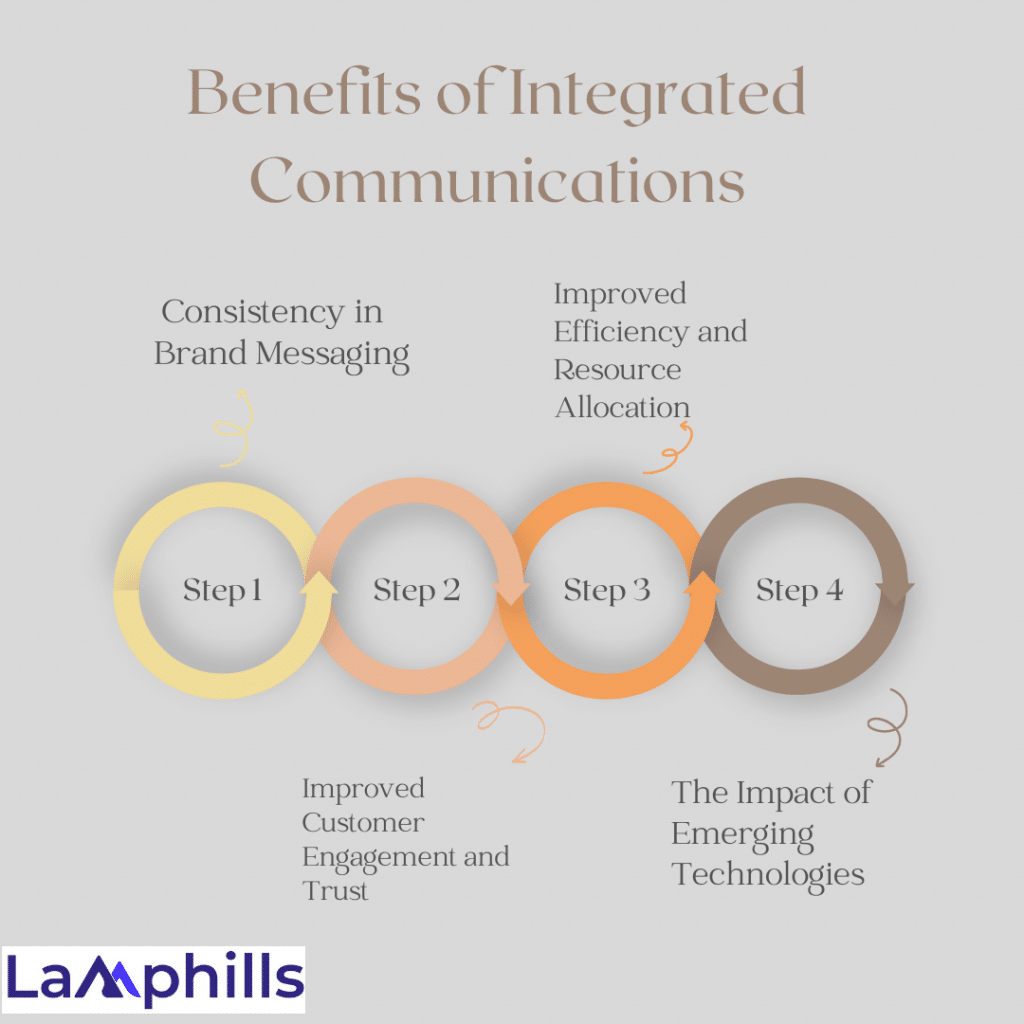
Integrated communications isn’t just a buzzword; it’s a game-changer for businesses looking to build stronger connections with their audience. Here are some key benefits:
#1. Consistency in Brand Messaging
Imagine your brand as a storybook, with each chapter, page, and word conveying the same tone and meaning. Integrated communications guarantees that your brand speaks with a consistent voice across all platforms, including your website, social media accounts, and customer service contacts. Consistent messaging increases brand awareness and trust, allowing your audience to better grasp who you are and what you stand for.
#2. Improved Customer Engagement and Trust
In today’s congested market, attention is the most valuable commodity. Integrated communications enable you to cut through the clutter and capture the hearts and minds of your target audience. Delivering consistent, relevant, and tailored communications across many touchpoints creates meaningful connections with your customers, increasing engagement and building
Take Starbucks, for instance. From their mobile app to their social media presence to their in-store experience, Starbucks delivers a consistent brand experience that resonates with coffee lovers worldwide. By integrating their messaging and customer experience across channels, Starbucks has built a loyal community of caffeine aficionados who keep coming back for more.
#3. Improved Efficiency and Resource Allocation
Integrated communications isn’t just good for your brand; it’s good for your bottom line too. By streamlining your communication processes and consolidating your resources, you can save time, money, and effort. Whether it’s through centralized content management systems, automated workflows, or cross-functional collaboration, integrated communications allow you to do more with less, maximizing the impact of your efforts.
#4. The Impact of Emerging Technologies
The future of integrated communications is bright, and it’s powered by emerging technologies such as AI, blockchain, and IoT. Here’s how these technologies will shape the future of communication:
#1. AI (Artificial Intelligence): AI has the potential to transform integrated communications by allowing for tailored, data-driven interactions at scale. From chatbots that give quick customer care to predictive analytics that anticipate customer demands, AI enables brands to send hyper-targeted communications that are relevant to individual tastes and habits.
#2. Blockchain technology provides unprecedented transparency and security in communication. By producing immutable, tamper-proof records of transactions and interactions, blockchain assures that messages are genuine, trustworthy, and difficult to alter. This not only increases trust between brands and consumers but also creates new opportunities for safe, decentralized communication networks.
#3. IoT (Internet of Things): The growth of IoT devices opens up new possibilities for integrated communications. By connecting common devices to the internet, marketers may collect real-time data on customer behavior and preferences, resulting in more tailored and contextually relevant messages. Whether it’s sending customized offers to smart refrigerators or providing location-based notifications to wearable devices, IoT allows for seamless communication experiences that blur the distinction between physical and digital channels.
Finally, integrated communications provide numerous benefits, ranging from consistent brand messaging to increased consumer engagement and efficiency. As we look ahead, emerging technologies such as AI, blockchain, and IoT will continue to influence how we communicate, opening up new possibilities for personalized, secure, and connected experiences.
What is an integrated communication major?
You take courses in integrated communication research methods, media, and public relations strategies and practices.
What are integrated communications systems?
The Integrated Communications System (ICS) is a hardware device or a set of hardware that allows communications protocols/interfaces as diverse as conventional PMR (UHF, VHF, and HF), TETRA, digital telephony, analog telephony, GSM, CDMA, and VoIP to interact seamlessly.
What is the meaning of integrated communication services?
Integrated communications services offer to design, implement, and manage communication and networking environments to optimize business communication and outcomes.
What is the goal of integrated communication?
The goal of integrated marketing communications is to ensure that customers receive the same message when they interact with a company’s brand in various ways.
Final Thoughts
The growth of IoT devices opens up new possibilities for integrated communications. By connecting common devices to the internet, marketers can collect real-time data on customer behavior and preferences, resulting in more tailored and contextually relevant messages. Whether it’s sending customized offers to smart refrigerators or providing location-based notifications to wearable devices, IoT allows for seamless communication experiences that blur the distinction between physical and digital channels. Hence, I encourage firms to recognize the value of integrated communications and make it a key component of their marketing strategy. B
References
- beehivepr.biz
- online.purdue.edu
- tunheim.com






